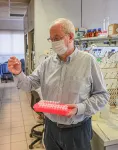(Press-News.org) Wherever ecologists look, from tropical forests to tundra, ecosystems are being transformed by human land use and climate change. A hallmark of human impacts is that the rates of change in ecosystems are accelerating worldwide.
Surprisingly, a new study, published today in Science, found that these rates of ecological change began to speed up many thousands of years ago. "What we see today is just the tip of the iceberg" noted co-lead author Ondrej Mottl from the University of Bergen (UiB). "The accelerations we see during the industrial revolution and modern periods have a deep-rooted history stretching back in time."
Using a global network of over 1,000 fossil pollen records, the team found - and expected to find - a first peak of high ecosystem changes around 11,000 years ago, when the Earth was coming out of a global ice age. "We expected rates of ecological change to be globally high during this transition because the world was changing fast as glaciers retreated and the world warmed" explains co-lead author Suzette Flantua. However, the timing of peak changes varied among regions, suggesting a fairly complex suite of climate and ecosystem changes during the end of the last ice age.
More surprisingly, the team found a second period of accelerating change that began between 4.6 and 2.8 thousand years ago and has continued to present. Remarkably, these recent rates of change are now as fast or faster as the massive ecosystem transformations that accompanied the end of the last ice age.
To achieve this global analysis, the team developed new statistical tools that allowed them to calculate rates of change in stratigraphic sequences. "We found a way to compare the many records across different continents and smaller regions" explains Alistair Seddon at UiB and Bjerknes Centre for Climate Research. "That was a major breakthrough as it allowed us to demonstrate that different regions experienced peak rates of change at different times".
The study was made possible by scientists working together to create a global resource of fossil data, called the Neotoma Paleoecology Database (https://www.neotomadb.org), available freely to everyone. "Paleoecology is quickly transitioning from a local science to a global science, powered by the ongoing growth in open-access global databases and by the urgent scientific need to better understand how ecosystems respond to environmental change, at local to global scales." John (Jack) Williams said, co-senior author and a paleoecologist at the University of Wisconsin-Madison (USA).
More work is needed to understand and confirm the causes of these accelerations in rates of vegetation change. "Although some patterns seem more obvious than others, we are actually not sure which changes were caused by humans, climate, or both", clarifies Mottl. The next step forward is therefore to compare these global networks of fossil data to independent evidence of past climate change and archaeological findings. "Bringing multiple lines of evidence together should help us better understand how climate, humans, and ecosystems interacted." says Flantua who is also keen to increase the number of pollen records from the southern hemisphere where gaps in the analyses remain. An ongoing ERC project called HOPE (Humans on Planet Earth), led by Prof. J. Birks (UiB) will make strides forward and as more data is integrated, more decisive conclusions can be presented on the role of humans in shaping modern-day ecosystems.
Sadly, one of the co-founders of Neotoma and study co-author, Dr. Eric C. Grimm, passed away unexpectedly as this work was nearing completion. Eric was a much-loved palynologist who made enormous contributions to the analyses of pollen records from around the world. Thanks to his advocacy of open and shared data and software, he built the foundation for this study, and undoubtedly for many studies ahead. The other authors have dedicated this paper to his memory.
INFORMATION:
Mottl, O.*, Flantua, S.G.A.*, Bhatta, K.P., Felde, V.A., Giesecke, T., Goring, S., Grimm, E.C., Haberle, S., Hooghiemstra, H., Ivory, S., Kuneš, P., Wolters, S., Seddon, A., Williams, J.W. (2021) Global acceleration in rates of vegetation change over the last 18,000 years. Science 372 (6544): 860-864 (* first co-authorship)
All the data and R codes are publicly available at: https://github.com/HOPE-UIB-BIO/Global_RoC
The study was funded by European Research Council (ERC) under the European Union's Horizon 2020 research and innovation program (grant agreement no. 741413) to H. J. B. Birks. Neotoma development has been supported by the National Science Foundation (1550707, 1550805, and 1948926) and Belmont Forum (1929476).
Related study: Mottl, O., Grytnes, J.A., Seddon, A.W.R., Steinbauer, M.J., Bhatta, K.P., Felde, V.A., Flantua, S.G.A., Birks, H.J.B. (2020) Rate-of-change analysis in palaeoecology revisited: a new approach. Pre-print: https://www.biorxiv.org/content/10.1101/2020.12.16.422943v1
Bradshaw, R.H.W., Styles, B., Giesecke, T., Flantua, S.G.A., Bittmann, F., Williams, J.W., 2021. Eric C. Grimm 1951-2020. Veget Hist Archaeobot. https://doi.org/10.1007/s00334-021-00828-z
Carbon exists in various forms. In addition to diamond and graphite, there are recently discovered forms with astonishing properties. For example graphene, with a thickness of just one atomic layer, is the thinnest known material, and its unusual properties make it an extremely exciting candidate for applications like future electronics and high-tech engineering. In graphene, each carbon atom is linked to three neighbours, forming hexagons arranged in a honeycomb network. Theoretical studies have shown that carbon atoms can also arrange in other flat network patterns, while still binding to three neighbours, but none of these predicted networks had been realized until now.
Researchers at the University of Marburg ...
Analyzing data obtained with the Atacama Large Millimeter/submillimeter Array (ALMA), researchers found a galaxy with a spiral morphology by only 1.4 billion years after the Big Bang. This is the most ancient galaxy of its kind ever observed. The discovery of a galaxy with a spiral structure at such an early stage is an important clue to solving the classic questions of astronomy: "How and when did spiral galaxies form?"
"I was excited because I had never seen such clear evidence of a rotating disk, spiral structure, and centralized mass structure in a distant galaxy in any previous ...
A new study published in the journal Science, highlights the opportunity to complement current climate mitigation scenarios with scenarios that capture the interdependence among investors' perception of future climate risk, the credibility of climate policies, and the allocation of investments across low- and high-carbon assets in the economy.
Climate mitigation scenarios are key to understanding the transition to a low-carbon economy and inform climate policies. These scenarios are also important for financial investors to assess the risk of missing out on the transition or making the transition happen too late and in a disorderly fashion. In this respect, the scenarios developed by the platform of financial authorities ...
Deaths caused by indirect effects of the pandemic emphasize the need for policy changes that address widening health and racial inequities.
More than 15 months into the pandemic, the U.S. death toll from COVID-19 is nearing 600,000. But COVID-19 deaths may be underestimated by 20%, according to a new, first-of-its-kind study from Boston University School of Public Health (BUSPH), the University of Pennsylvania, and the Robert Wood Johnson Foundation.
Published in the journal PLOS Medicine, the study uses data from the National Center for Health Statistics (NCHS) and the Centers for Disease Control and Prevention ...
ITHACA, N.Y. - Cornell University engineers and plant scientists have teamed up to develop a low-cost system that allows grape growers to predict their yields much earlier in the season and more accurately than costly traditional methods.
The new method allows a grower to use a smartphone to record video of grape vines while driving a tractor or walking through the vineyard at night. Growers may then upload their video to a server to process the data. The system relies on computer-vision to improve the reliability of yield estimates.
Traditional methods for estimating grape ...
INFORMS Journal Information Systems Research Study Key Takeaways:
In real-time feedback the relationship source (peer, subordinate or supervisor) plays a role: the feedback tends to be more critical when it is from supervisors.
Favoritism and retribution are impacted in real-time feedback: Supervisors adopt tit-for-tat strategies, but peers do not.
Men rate women higher than men, and women rate men and women similar to how men rate men.
Positive real-time feedback has a stronger effect on future ratings than negative feedback.
CATONSVILLE, MD, May 20, 2021 - To deliver real-time feedback to support employee development and rapid innovation, many companies are replacing formal, review-based performance management with systems that enable frequent and continuous employee evaluation. ...
Astronomers using NASA's Hubble Space Telescope have traced the locations of five brief, powerful radio blasts to the spiral arms of five distant galaxies.
Called fast radio bursts (FRBs), these extraordinary events generate as much energy in a thousandth of a second as the Sun does in a year. Because these transient radio pulses disappear in much less than the blink of an eye, researchers have had a hard time tracking down where they come from, much less determining what kind of object or objects is causing them. Therefore, most of the time, astronomers don't know exactly where to look.
Locating where these blasts ...
According to the Centers for Disease Control and Prevention, approximately 22 percent of older adults in the United States suffer from a functional impairment, defined as difficulties performing daily activities, such as bathing or getting dressed, or problems with concentration or decision-making affected by physical, mental or emotional conditions.
In a new study published in the May 20, 2021 online edition of the American Journal of Preventive Medicine, researchers at University of California San Diego School of Medicine found that functional impairments among adults aged 50 and older are associated with a higher risk of medical cannabis use; and prescription opioid and tranquilizer/sedative use and misuse.
"Our ...
A team of Spanish researchers have developed, at the laboratory level, a prototype of a new biosensor to help detect breast cancer in its earliest stages. One of the team coordinators has been Ramón Martínez Máñez, a professor at the Universitat Politècnica de València (UPV) and the scientific director of the Networking Biomedical Research Centre in Bioengineering, Biomaterials and Nanomedicine (CIBER BBN). The other one has been Ana Lluch, a Valencian oncologist, co-coordinator of the Breast Cancer Biology Research Group ...
Leave voters in Cornwall wanted to exit the EU to "take back control" and express concern about immigration - even though most said the movement of people across the continent had not caused issues for them, a new survey suggests.
A total of 56.5 per cent of people in Cornwall voted to Leave the EU in 2016, yet the area has received some of the highest levels of EU structural funding in England.
There have long been campaigns for Cornwall to have more political autonomy, but hardly anyone who took part in the research said they voted to Leave said they do so to get more power for politicians in the county.
The most frequent reason given, found in 79 responses to the survey, was the UK had lost control to ...





